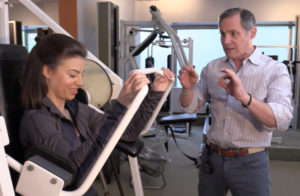![]()
Relationships generally interest me, but none more so than those where correlation is misunderstood as causation. This logical fallacy, known as false cause, can be especially misleading when navigating the ‘exercise-to-lose-weight’ conundrum.
It was not all that long ago when it was considered naïve by health practitioners to believe that increased activity contributed to fat loss. Louis Newburgh of the University of Michigan determined in 1942 that a 250-pound man would only burn three calories by walking up a flight of stairs. Newburgh calculated that “He will have to climb twenty flights of stairs to rid himself of the energy contained in one slice of bread!” The only thing Newburgh could say of exercise was that it would make that same man hungrier.
Then, during the sixties, nutritionist Jean Mayer, the future president of Tufts University, contradicted that mainstream thinking arguing that a ‘sedentary lifestyle’ was the primary cause of our Nation’s obesity problem. Mayer and other physicians of the time were shocked to learn that obese patients often ate less food than their leaner counterparts. They also observed that obese people were much less active. Mayer therefore concluded (and heavily promoted) that low levels of activity were the cause of obesity.
It surprises me that today’s medical community still believes that inactivity causes obesity. We frequently hear that as an industrialized and modern nation, we are drastically less active, expend significantly fewer calories, and therefore are overweight.
Our advancements as a society have afforded us convenience and accessibility. True, but this is a perfect example of when a correlation does not realize causation!
Assistant Professor of Anthropology at Hunter College, Dr. Herman Pontzer recently put the ‘sedentary lifestyle’ theory to the test. Dr. Pontzer and his colleagues measured the high daily energy expenditure among the Hadza people of Tanzania, one of the few remaining traditional hunter-gatherer populations. Would the Hadza, whose lifestyle is exceptionally non-sedentary, expend more energy than we do?
Unexpectedly, Pontzer and his team found that they don’t expend more energy than us – suggesting that inactivity is not the source of today’s obesity problems. Their findings were published in a study last July.
In a New York Times article (August 24, 2012), Pontzer wrote:
“How can the Hadza be more active than we are without burning more calories? It’s not that their bodies are more efficient, allowing them to do more with less: separate measurements showed that the Hadza burn just as many calories while walking or resting as Westerners do…
We think that the Hadzas’ bodies have adjusted to the higher activity levels required for hunting and gathering by spending less energy elsewhere. Even for very active people, physical activity accounts for only a small portion of daily energy expenditure; most energy is spent behind the scenes on the myriad unseen tasks that keep our cells humming and our support systems working. If the Hadza’s bodies somehow manage to spend less energy in those areas, they could easily accommodate the elevated energy demands of hunting and gathering. And indeed, studies reporting differences in metabolic-hormone profiles between traditional and Western populations support this idea (though more work is needed).”
Asserting that inactivity is not the source of today’s obesity problems, Dr. Pontzer surmises that “the Hadza’s bodies somehow manage to spend less energy” at other times of their daily life in order to compensate for the high “energy demands of hunting and gathering.”
Pontzer is referring to ‘homeostasis’ – the physiological mechanisms that regulate and stabilize all of our biological functions, including energy expenditure. As Harvard physiologist Walter Cannon put it back in the thirties, “Somehow the unstable stuff of which we are composed had learned the trick of maintaining stability”. It is possible that the Hadza slept more in order to maintain an energy balance.
Here’s the kicker folks – most homeostatic regulation is controlled by the release of hormones into the bloodstream. Insulin, a hormone and the primary regulator of how we store fat, is secreted into our bloodstream in response to the carbohydrates in our diets – when our insulin levels are elevated, fat accumulates in our fat cells.
Put simply, insulin can increase the fat our bodies store and decrease the fat we burn, irrespective of our activity levels. Eliminating grains and sugar from our diets is more critical than increasing activity to lose fat because they raise our blood sugar and therefore raise our insulin levels.
While not offering scientific proof, we did however demonstrate in last week’s blog post, The ‘Lose Fat and Get Strong’ Challenge’, the case of Inform Fitness client David Restrepo, who dropped 40 pounds in only eight months and has since maintained his weight. David’s success was attributable to two things: (1) performing the Power-of-10 workout a mere 40 minutes a week at our prescribed level of intensity; and (2) eliminating grains and sugars from 80 percent of his diet. With absolutely no additional cardio, David’s results belie the cardinal rule of conventional weight-loss ‘wisdom,’ that a high level of activity is necessary for sustained fat loss.
It is more likely that by keeping his insulin levels low, David not only decreased the amount of fat he stored, he also increased the amount of fat he mobilized and utilized for fuel (fat burned during his workouts).
We are all different and have different sensitivities to insulin based on aspects of our diet and lifestyle, as well as our genetic predispositions and age. Given the same food and the same amount of carbohydrates, some people will secrete more insulin than others, and that insulin’s exponential effect on our overall level of insulin resistance will vary. In addition, we all have different sensitivities to foods that may or may not stimulate insulin secretion, such as dairy, nuts, diet sodas and coffee.
So we can be fat and sedentary, or fat and active. The hormone insulin and not our activity level is what governs our body-fat percentage. The positive correlations that can be drawn between physical activity and our health, and even our weight, are many! But, it is more than likely that our physical activity levels are not the primary cause of body fat either being stored or burned. The food that we put into our mouths and its effect on the secretion of insulin will determine our state of fatness.
Once again, it’s those darned hormones that are the blame for everything.
![]()









